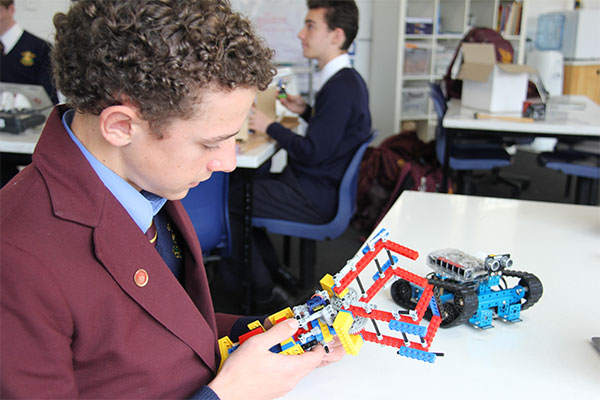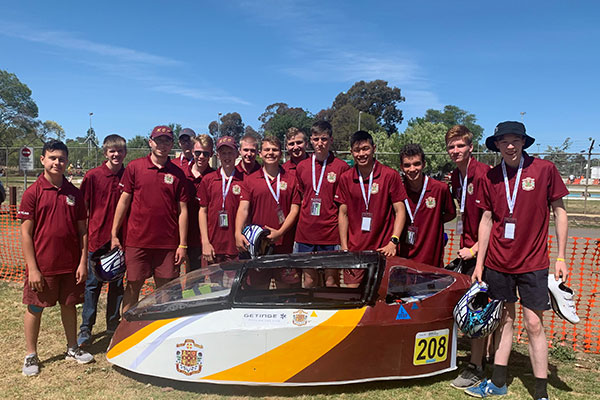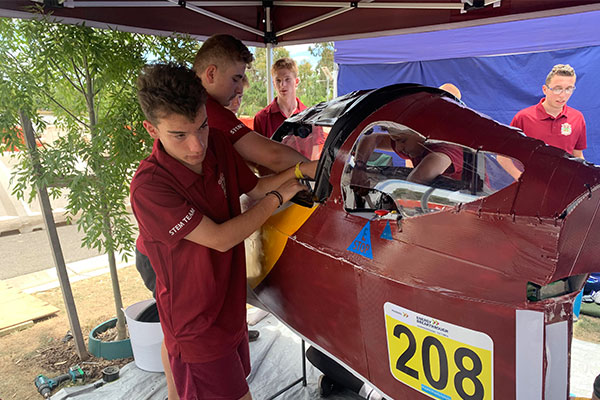Holy Cross College Ryde students are reaching for the stars in rockets designed in Science, Technology, Engineering and Mathematics (STEM) classes.
Their STEM story began in 2019 with a single 3D printer, limited resources and a group of students with the will and determination to extend themselves.
Today STEM is one of the fastest growing electives and the most popular extracurricular activities at the secondary school.
David Ratcliffe, a TAS (technological and applied studies) and VET (vocational education and training) teacher at Holy Cross, said their STEM course focuses on making industry links and partnerships “to aid our students to see and seek future opportunities they may not have thought was possible”.
“The course provides students with a truly holistic understanding of how their learning relates to real world situations and the hands-on challenge provides these experiences for our students,” he added.
“We have seen some amazing designs rebuilt, redesigned or re-engineered out of broken or discarded items” – David Ratcliffe
Mr Ratcliffe made special mention of Year 12 STEM student Georgio Anastasiadis who has gained early admission to University of Technology Sydney (UTS) where he will study Flexi Engineering.
“They were more interested in the STEM activities he did while at school than anything else,” Mr Ratcliffe laughed.
Making a mark in STEM
Principal Phillip Stewart said Holy Cross had achieved “some great successes in the short amount of time we have journeyed into the world of STEM”.
They include:
- NRMA Challenge – Runners-up and only male school to reach the top 4
- Robocup Rescue and Robotics – Division winners in 2020
- SUBS in Schools Technology Challenge – NSW runners-up
- FIRST Tech Challenge – Top 5 in the Regional Challenge in the school’s first year of competition
- Energy Breakthrough – Second Place in the 24-hour race challenge for EEV
- Hosting multiple workshops with Engineers Australia
- Australian Space Design Competition.
“Even parents have contacted our team to tell us what their son has built at home that has truly surprised and impressed them” – Daniel Ratcliffe
STEM in the classroom
Starting with Aerodynamic studies, Holy Cross’ STEM course challenges students to design and build proto planes and rockets with improved functionality, then moving onto Biomedical Innovation and Technology.
Students build replacement body parts and machines for patients in undeveloped countries, gaining a deeper respect for all those in the biomedical industry and improving the lives of people worldwide.
Break-out point: The course continues with Mechatronics and Designing for Space in which students develop proto vehicles and rescue robots for disaster situations where humans are unable to go.
It concludes with a motion unit in which teams are given the largest challenge of the course – to design and build a fully operational EEV (Energy efficient Vehicle) they then enter into the Energy Breakthrough: 24-Hour race challenge in Melbourne.
“At the [24-Hour race challenge] event, after 18 hours of continuous racing with the end in sight, things went wrong and problems kept coming up,” Year 10 STEM student Luke Brutto recounted.
“But it wasn’t our teacher we needed to keep calling – it was just each other – and what we have been taught that got us through anything that came up.
“After 24 hours we knew we had done this ourselves and even though it was one of the hardest things we had ever done, I know the skills we used over those five days I still use today.”
Current STEM projects
- Year 9’s are developing a surgery machine in the Biomedical Innovation Unit
- Year 10’s are refining their Mini EV model solar cars for an upcoming school solar car challenge
- Engineering students are working on a hybrid mini motorcycle
- Extracurricular teams are taking part in the world’s first in-class submarine design competition known as SUBS in Schools Technology Challenge 2021/2022 and will also participate in the FIRST Tech Challenge 2021/2022 where they will design, build, and code a robot to compete in an alliance format against other teams.




